When I tested a decorated Bachmann Peter Witt car right out of the box on the Southern California Traction Club test track, it ran smoothly and quietly in the two-rail mode. But when running in the overhead pickup mode, I found that while the stock trolley wheel negotiated most of the frogs on our overhead wires, the upward tension on the pole was insufficient to provide consistent electrical contact. Since our traction club (Southern California Traction Club) rules require all trolley poles to be readily removable, I chose to modify the roof to accept an SCTC-2 insulator along with an SCTC-1 pole pivot. This allowed the installation of a Miniatures by Eric HT-P2 pole. All three products are available from Custom Traxx. The pole pivot (SCTC-1) had to be shortened by about 1/8 inch to provide contact to the Bachmann spring contact on the upper circuit board and to permit the roof to be refastened to the body. A 1/16 inch hole was drilled in the spring to allow the pole base to pass thru the spring contact and to fully seat in the pivot.
Following are the details to the process: |
First, cut the "rope" from the trolley catcher (It can be replaced later if desired). Remove the floor by pulling out on the sides of the body. Four clips hold it in and should come off easily. Unplug the eight-pin inline connector from the underside of the upper circuit board. Set the motorized floor assembly aside. Remove the roof by again pushing out on the body sides. There are six clips here and is a little more difficult than the floor. I found that a thin X-acto knife blade helps in separation of the roof. The stock pole is held in by a small washer and screw on the underside. Once these are removed. the small square pole platform is removed. The hole through the roof needs to be enlarged with a fine round file to accept the SCTC-2 insulator. The unmodified SCTC-1 pole pivots are currently .375 inch in overall length. Enough material was removed so that the new length is approximately .250 inch. See the photo 1 at right: |
|
| The 1mm trolley base mount of the Miniatures by Eric HT-P2 trolley pole should now protrude beyond the bottom of the shortened SCTC-1 pivot as seen in the adjacent photo 2: |
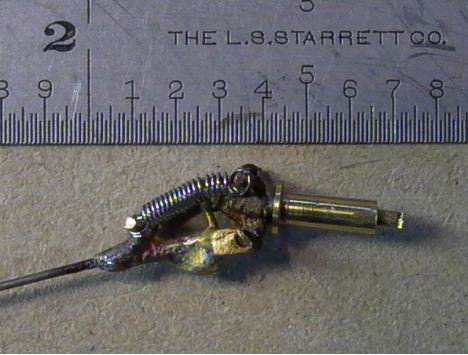 |
The SCTC-2 insulator and the shortened SCTC-1 pole pivot are glued in place with CA glue, taking great care to not get any onto the bottom surface of the pivot tube. This is the point of electrical contact with the spring and will be critical for reliable operation, especially with DCC. The adjacent photo 3 shows the underside of the Bachmann roof with the SCTC-1 and SCTC -2 clearly visible.
For the top view of the roof with both items installed and secured, see photo 4 below: |
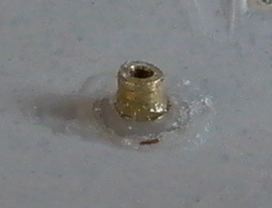 |
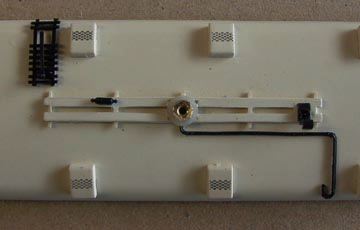 |
In order to allow the 1mm trolley pole base mount to extend below the contact spring, a hole is made through it. A longer pole mount is preferred as the pole will more likely remain on the car after a dewirement. Poles with shorter pole mounts have the annoying habit of getting "lost" after a dewirement. In some cases, poles have been discovered up to three feet away from such an incident and in rare cases never seen again. The hole was drilled as shown in photos 5 and 6 below with a sharp cone shaped metal cutting tool inserted in a Model 780 cordless Dremel tool. the hole was started just to the left (rear) of the raised dimple in the spring. The hole should be large enough for the 1mm pole mount pivot to pass through but not large enough to pass the entire SCTC-1. |
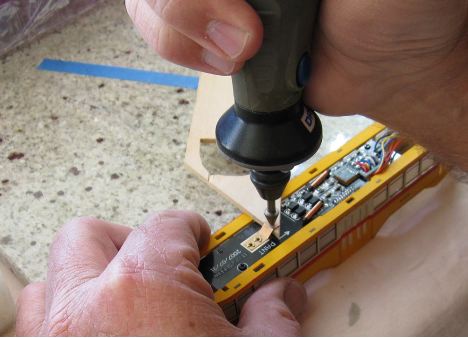 |
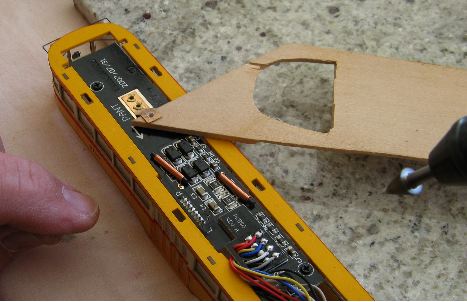 |
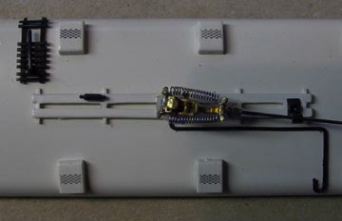 |
The above procedures allow for full rotation of the pole as well as providing for removability. Finished installation is shown in photo 7 at left. The Bachmann Peter Witt trolley was then reassembled and began further testing on the club test track and negotiated the 6", 9" and 12" radius curves. The pole tracked reliably through all overhead frogs and crossings.
This modification adds greatly to the versatility of this fine trolley model. The final photo below shows several modified Bachmann Peter Witt cars belonging (l to r) to George Huckaby, myself and Pete Debeers all running on the club test track under DCC with overhead wire pick-up. |
|
|